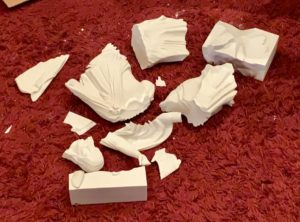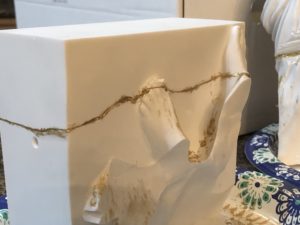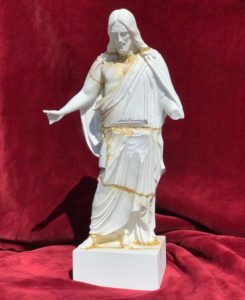This article is an invitation to understand faith transition and visually see what it might look like on the other side. For me, the context in which we approach hard subjects matters. The first half of this article speaks to that context. If you prefer, you can scroll down to #BreakingJesus, but I invite you to read the entire article.
You may have wandered into this article expecting an anti-religious rant of some kind. You may be triggered by the picture that introduced this article. Your defenses may be up. You may be bracing for a debate over particular points of doctrine or an attack on your faith.
Or you may be someone for whom the deconstruction of your religious beliefs has left you broken and shattered. When you reach out to others in your faith community with raw feelings and high emotions you just can’t connect. Or more significantly, you reach out to your spouse or parents or siblings and feel a devastating silence.
The interpersonal nature of religious belief runs deep. We form families and community based on a shared foundation and structural expectations. One of those expectations is that the foundation is unshakeable, and the rules of life won’t change. But when this happens it is devastating because often our loved ones cannot see or understand us. You are cast adrift and alone.
I was recently listening to “Running Up That Hill” originally by Kate Bush (1985) and recently covered by Meg Myers. I have always loved this song, but I found that for the first time I was being drawn significantly to the deep emotion of the lyrics. The song is about two people who genuinely love each other but fundamentally do not understand each other.
https://www.youtube.com/watch?v=0LR7VvxWWpo
It doesn’t hurt me.
Do you want to feel how it feels?
Do you want to know that it doesn’t hurt me?
Do you want to hear about the deal I’m making?
You, it’s you and me.
You can feel the tension between them. The misunderstanding and conflict between them is hurting them both. They continue to speak past each other. You get the sense of how earnest they are and how they just want to be understood. Then she makes the invitation:
And if I only could,
I’d make a deal with God,
And I’d get him to swap our places,
Be running up that road,
Be running up that hill,
Be running up that building.
If I only could, oh…
What if we could take our loved ones into our heart and mind? What if they could walk with us through the heartbreaking experience of our faith transition? Not to deconstruct their faith, but to simply be understood; an invitation for them to feel what we feel.
You don’t want to hurt me,
But see how deep the bullet lies.
Unaware I’m tearing you asunder.
Ooh, there is thunder in our hearts.
Our loved ones who are still in the faith do not want to hurt us. It is often inconceivable that their faith could be causing us such deep wounds. Finding space to come together and honor our wounds and complex feelings is challenging. Hence, the deal with God to swap places for just a moment; if only to feel the other’s intentions and understand that these wounds are real.
Is there so much hate for the ones we love?
Tell me, we both matter, don’t we?
You, it’s you and me.
It’s you and me, we won’t be unhappy.
I write this article as an invitation made with love. I invite you to feel some of the wounds and trials of a faith transition; and the beauty of what is on the other side. I don’t believe that our family and community hate us. But these divisions and the misunderstanding that surround this experience can cause significant unhappiness, for both sides. It can cause trauma between spouses that results in divorce. It can cause trauma that divides siblings. It can cause a parent to cut off their children.
So, let’s make a deal with God.
I will tell you in the most intimate and vulnerable way how my faith deconstruction happened. My intent is not to hurt your faith, although I am fully aware that this invitation to touch my personal cross might be painful. That is the crux of this conversation. You can’t understand me (or your loved ones) without sharing some of the pain of that experience. It isn’t pain aimed at wounding you or to make you unhappy. My hope is that perhaps vicariously, my story will provide you with insight into your own loved one’s experience or help you to have the conversation with them.
Ultimately, this is an invitation to step closer to your loved one who has gone through a faith transition. This is an opportunity to swap places and “run up that road, up that hill and up that building.” Be willing to step into a deeper space of vulnerability. The miracle on the other side is you will be able to gain some of the most significant relationships of your life. I never knew I could have such a deep connection with friends, who have become family to me. The catalyst every time has been the vulnerability to feel what the other feels, to mourn with those that mourn, to comfort those in need of comfort, and unconditionally stand with them.
C’mon, baby, c’mon darling,
Let me steal this moment from you now.
C’mon, angel, c’mon, c’mon darling,
Let’s exchange the experience, oh….
If I only could
Be running up that hill
With no problems….
#BreakingJesus
I didn’t intend to break Jesus.
Several months ago, it occurred to me that my faith transition felt very much like a Christus statue breaking. Many use the image of a shelf breaking. Heavy problems and questions continue to stack up on the shelf until the shelf buckles under the weight. While this analogy is useful, it fails to capture the significance and violence of your religious foundation shattering. Or that the repercussions of breaking will ripple throughout all your relationships. It also doesn’t capture the sense of betrayal and loss of foundational beliefs.
It may seem very disrespectful or violent to break a statue of Jesus; especially an image that is viewed by most Mormons as sacred. For me, the Christus statue represents Mormonism. As a child, I frequently saw the Christus statue at the visitor’s centers in Washington DC and Salt Lake City. It was eight feet tall and larger than life. It embodied a sense of peace and contentment. It hinted that within the walls of the temple, Jesus walked.
For me, breaking the Christus symbolically captures the disrespect and violence felt in a faith transition. It is a violation of trust and childlike innocence. Whether you agree with the reasons for a person’s faith transition, you can’t invalidate the experience. If you seek to invalidate the experience, you risk losing the relationship.
The breaking apart of the Christus is only half the equation. In the vacuum of belief, other ideas will flood into the space if you let them. Some will be so wounded that they won’t allow anything to be rebuilt. Others will find an expansion of spirituality into multiple faiths and ideas. “Love One Another” is a universal belief. The Golden Rule of “Do unto others as they have done unto you” is found in many faiths.
As my faith transition progressed and I personally grieved the loss of both Mormonism and many relationships, I began to experience significant expansion. I started to find that many of the symbols and beliefs from Mormonism were common throughout Christianity and most world religions. I began to study meditation and looking inward to find God instead of an outward search for meaning and religion.
The most significant gain, however, was reaching out and experiencing the pain and struggle borne by others. In that sharing and mourning together, I found my greatest inward expansion. My ability to hold the pain of others expanded. My ability to express compassion and have unconditional love for others grew. I began to feel an intimate depth of relationship with more people than I ever had before. Jesus actually embodies this ideal by touching other’s crosses, sharing their burdens and walking with us in our times of sorrow. This is a beautiful theology.
How could I keep these good beliefs as they evolved and grew? It was then that I came across the Japanese art of Kintsugi (or Kintsukori). Very simply, this idea or art form is to ‘repair with gold.’ It teaches that if something is broken, it isn’t something to hide; but something to display with pride. By using gold to repair the item, you highlight the break in a way that makes it beautiful. The breaks make it unique. Each break has its own story. Each break is honored.
As I continued to think about this imagery, I began to make it real. What were the breaks to my faith? The first one was obvious:
- Jordan – In January of 2012, Jordan (my oldest son) came out to us. His coming out was not the break, though. It was merely a single strike against the statue. Subsequent hits included how we were treated by our family and faith community. It was the absence of love in the theology. Another hit exposed the limits on families in Mormonism to a 1940s patriarchal model and held it up as God’s eternal standard. Ultimately, there is no place for LGBTQ people in Mormon heaven or eternity and thus no place for my family or my son. This break was a result of pounding blows that beat against the statue over weeks and months. And then it broke.
Other breaks I identified were:
- Susannah – My oldest daughter is a strong and fierce woman for whom the patriarchal model and limits on women never fit. She constantly challenged church leaders who tried to put her in a box and tell her who she needed to be.
- Stockton – Stockton was close to my oldest children. He was Jordan’s first kiss. He took his life in 2016. Whatever weight we place on truth and religion, they cannot exceed what we have lost. Stockton’s break represents all the lives lost to the pride of religion claiming they know the worth of a gay soul.
- Jim – Jim’s break represents a whole generation of gay souls who have suffered at the hands of religion. I know dozens of “Jims” who believed their bishops and leaders when they were told that a mixed-orientation marriage would fix them or cure them from being “gay.” But more significantly, Jim taught me that the depth of pain we share can create bonds more valuable, intimate and strong. He taught me how you can truly become someone’s brother.
- Steve and Susie – When I was a member still on the fence, my good friends left the church. To my surprise, their quality of life and happiness increased in a dozen different ways. It was antithetical to everything I had been taught about how miserable people are who leave the church. It was a lesson I had to see first-hand.
- Wendy (my wife) – Wendy and I broke together outside an LDS chapel the Sunday after the Exclusion Policy was leaked. Our foundation was shattered with the clarity that this church is causing harm and doing it in the name of God. The prophet invoked revelation for a policy that divides, marginalizes, demeans, and irrevocably hurts the most innocent among us. Within three months, Wendy was made aware of 32 suicides in the wake of the policy. She attended as many funerals as she could; and this Mama Dragon mourned with the mothers and fathers of the lost.

So, I invited all of the above people (Stockton was represented by his parents Alyson and George) to come to a ceremony at my house to break a 20”, 16.5 lbs. Christus statue. Starting with Jordan, each of them hammered away until they made a break. Sometimes it took a dozen hits. Sometimes it took a hundred hits. Frequently, the statue would break or fracture somewhere other than where the hammer was falling. The foundation especially took a lot of work to break. But when the foundation finally cracked, the statue had been fully broken. Everyone was emotional. Each strike with the hammer channeled the pain and anger of faith breaking.
It was a beautiful and meaningful ceremony. When all the pieces were broken and on the ground, my feelings were complex. It was a visual representation of my faith deconstruction. Yet it also felt incomplete. I had a yearning that its reconstruction would be as beautiful and rewarding as my faith transition has been.
 Over the next few weeks, I took my time putting the Christus back together piece by piece. It was cathartic to mix the gold dust into the epoxy glue and see each break made whole with beautiful clarity. As symbolically as the Christus had been dismantled, each piece was reset to both honor the break and honor how my spirituality has grown and expanded.
Over the next few weeks, I took my time putting the Christus back together piece by piece. It was cathartic to mix the gold dust into the epoxy glue and see each break made whole with beautiful clarity. As symbolically as the Christus had been dismantled, each piece was reset to both honor the break and honor how my spirituality has grown and expanded.
This rebuilt Christus is unique. There is only one Christus with these breaks. It was rebuilt with as much passion and emotion as it was dismantled. I can look at each break and know who and what it represents. I can feel the passion, feeling, and heartbreak that each caused; and also the beauty and healing honored in gold.
The statue is now me. Flawed and broken, yet beautiful in unique ways. It honors my scars and faith transition while pointing to a greater depth and spirituality. It has taught me that I can fall apart and put myself back together again. It has taught me to honor my scars. It has taught me to honor the scars I see in others as beautiful and unique.

